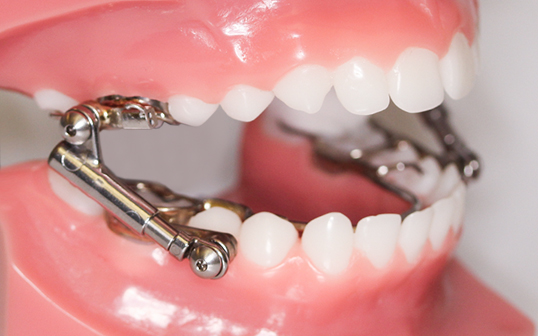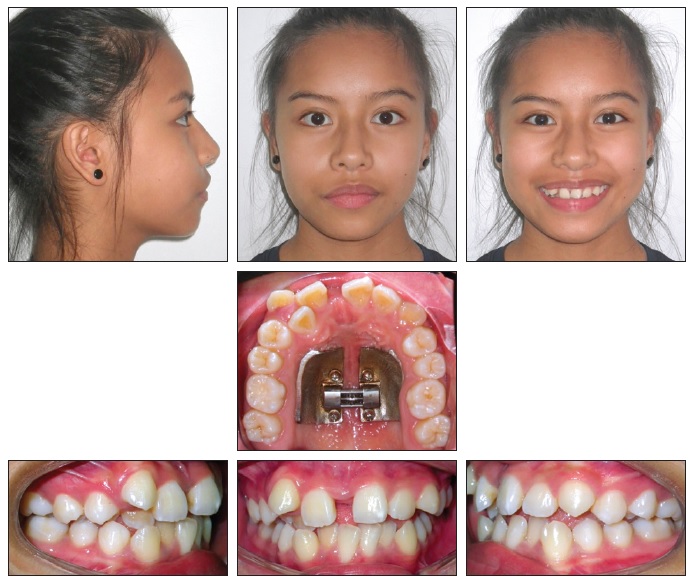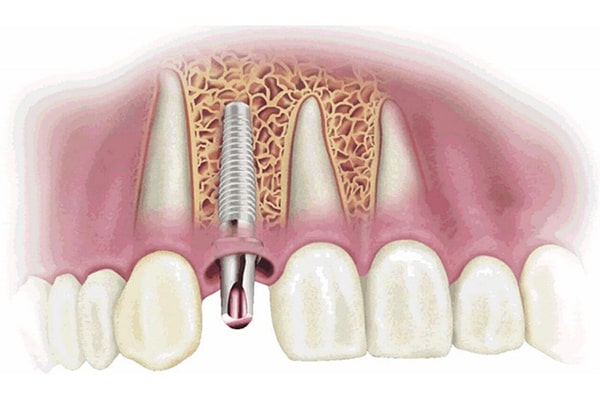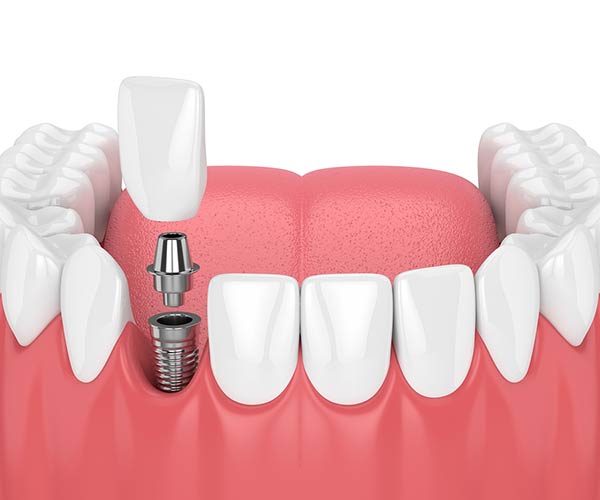Using an expander is an important step in orthodontic treatment to improve a narrow arch and lack of space. Currently, there are many devices available to expand the upper and lower jaw, each with different advantages and disadvantages. To learn more about each type, please refer to the article below.
Contents
What is Jaw Expansion?
Jaw expansion is a method that uses specialized appliances to widen the circumference of the jaw, increase the area of the oral cavity, and create more space between the teeth. This technique can help to widen crowded or crooked teeth and reduce the need to extract teeth before orthodontic treatment.
Jaw expansion can be applied to both traditional braces and clear braces and is recommended for cases such as:
- People with narrow jaw arch: If the jaw arch is narrow, the doctor may prescribe jaw expansion to create just enough space. This creates favorable conditions for orthodontics to return the teeth to their correct position and can limit the need for tooth extraction.
- The arch is not narrow but lacks tooth arrangement: In this case, the doctor prescribes moderate jaw expansion so as not to disrupt the facial structure.
- Misaligned teeth and posterior crossbite: these conditions can be corrected by using a jaw widening appliance to help align the bite and move the teeth to a more balanced position. With the use of transparent braces, the jaw expansion can be achieved by the aligners themselves. The orthodontist will also create a production plan for the aligners with the expansion plan.

The popular methods of jaw expansion
Currently, there are four commonly applied methods of jaw enlargement:
Rapid Palatal Expander (RPE)
Rapid jaw expansion can be achieved using appliances that are capable of expanding jaws from 0.5mm to 1mm per day. This method focuses on expanding the bone area, while simultaneously increasing the growth rate of bone faster than the speed of tooth movement. As a result, over time, the distance between the two incisors increases. To prevent this, customers must undergo cosmetic braces after rapid jaw expansion.
Slow Jaw Expansion
Slow jaw expansion can be achieved using a gradual jaw widening appliance at a rate of 1mm per week. This approach helps ensure that the rate of bone growth is proportional to the speed of tooth movement, reducing the movement of the two incisors and resulting in less pain compared to rapid jaw expansion.
Jaw Expansion with Archwire
The archwire is typically used for crooked or slightly crowded teeth. However, it may not be very effective as a jaw expander. If there is no improvement after 5-6 months, the doctor will recommend another appliance.
Types of Dental Expanders
In dentistry, there are two types of appliances to help widen the jaw: removable and fixed jaw expanders.
Removable Jaw Expander
Removable dentures come in two types suitable for different age groups. For children aged 4 to 7 who are just entering the tooth replacement period, orthodontists often prescribe EF appliances for night-time wear, at least 8 hours per day, to widen the jaw. EF is an instrument that can be used early with many effects, including widening the jaw, reducing breathing problems, deep bite, and underbite. Therefore, it is important for children to have an experienced orthodontist to assign the right type of EF based on their condition. Parents should not buy EF appliances arbitrarily for their children.
In addition to the previously mentioned methods, there is another option available for expanding the jaw area that is commonly used for individuals of older age. This option involves the use of an appliance with a structure that includes lip arches, springs, and screws. The appliance is designed to gradually expand the jaw area over time.
The benefits of using a removable expander appliance include the ease of removal for cleaning and eating, as well as the ability to address conditions such as a narrow jaw and malocclusion. However, it is important to note that the effectiveness of this method may be limited as customers must frequently remove and re-install the appliance in order to achieve the desired results. Additionally, it is recommended that individuals consult with a dental professional to determine if this option is the best course of action for their specific needs.
Fixed Jaw Expander
This traditional instrument is popular among many people due to its fast effects in shortening the time required to expand the jaw. However, customers using fixed dentures may initially experience discomfort, entanglement, and difficulty cleaning their teeth.
Can the Lower Jaw be Expanded too?
In dentistry, expansion is primarily used for the upper jaw, although there are cases where it can be used for the lower jaw, known as bihelix. However, the effect is not as significant as when expanding the upper jaw. Moreover, before performing expansion for the lower jaw, the doctor needs to carefully evaluate the bone quality and the health of the gums.
Is It Painful to Wear the Jaw Expander?
The procedure for wearing a jaw expander involves the following basic steps:
- Step 1: The dentist performs an examination, takes X-rays, evaluates the current state of the teeth, and decides whether to expand the jaw.
- Step 2: The dentist takes an impression of the jaw.
- Step 3: If you choose fixed jaw expansion, the dentist will fit the appliance and adjust it to suit your teeth. If you choose a removable denture, the dentist will guide you on how to wear and clean the appliance properly.
- Step 4: The dentist removes the appliance after the jaw is expanded. Then, the patient prepares for the next steps of braces (if any).
Generally, wearing a jaw expander creates thrust to expand the bone density and cartilage tissue in the upper jaw. Therefore, feeling pain is unavoidable. Depending on the location or device being used, the level of pain can vary. For example, a rapid palatal expander may feel more painful than a slow expander.
To minimize pain during jaw expansion, customers should choose a reputable dental clinic with a team of skilled doctors and modern equipment. This will help ensure a comfortable experience with as little pain as possible.
Can a Jaw Expander Change Your Face?
Wearing a jaw expander theoretically helps to stretch the bone gap and increase the area of the palate, potentially altering the face. However, any degree of change is likely to be insignificant and difficult to perceive with the naked eye.
Jaw expansion not only solves the issue of a narrow jaw, but also widens it. As a result, most facial changes that occur are positive, helping to make the jaw arch more symmetrical.

What is the cost of a jaw expander device?
To determine how much to wear a denture expander, customers rely on the following 3 factors:
- Condition of jaw frame and teeth: If the jaw frame is slightly deviated and there is enough space between the teeth, the customer may only need a simple jaw expansion. In these cases, the cost can be lower than in more complex cases.
- Instruments: The price of each type of jaw expander varies depending on the material and origin. Specifically, genuine imported instruments from abroad tend to be more expensive than those of unknown origin.
- Doctor’s experience: Jaw expansion is a complicated procedure that requires a highly qualified orthodontist to provide an effective and comfortable experience for the customer. This factor also affects the cost of jaw enlargement. If the procedure is performed by a reputable dentist, the cost will be higher but the procedure will be safer compared to an unreliable provider.
Notes on Jaw Expansion and Teeth Care
Wearing an appliance to widen the jaw can cause entanglement and pain for the patient. Therefore, it is important to take appropriate care to reduce discomfort. Here are some tips:
- Follow your doctor’s prescription: If the pain is severe and you need pain relievers, follow the doctor’s prescription to ensure safety for your health.
- Diet when expanding jaw: In the first few days of wearing a jaw expander, stick to soft and liquid foods instead of tough foods that can cause pain and affect the effectiveness of jaw enlargement. Also, cut food into small pieces to avoid it getting stuck in the appliance, which can adversely affect oral health.
- Cleaning the expander: Use a small specialized brush, floss, or water flosser to remove plaque from the appliance. Check here for instructions on how to use a water flosser.
- Oral hygiene when expanding the jaw: When wearing a device to expand the jaw, it may be difficult to clean with a brush or bamboo toothpick. Instead, use an antibacterial mouthwash or choose a water flosser to clean your teeth more effectively.
After reading the above information, it is hoped that you have gained a better understanding of jaw expansion devices. This is a specialized orthodontic technique that supports achieving optimal results. However, it is important to note that wearing a jaw expander requires a qualified doctor to perform the procedure and follow up with the patient to promptly address any arising issues. This is necessary to ensure both safety and long-term effectiveness.















